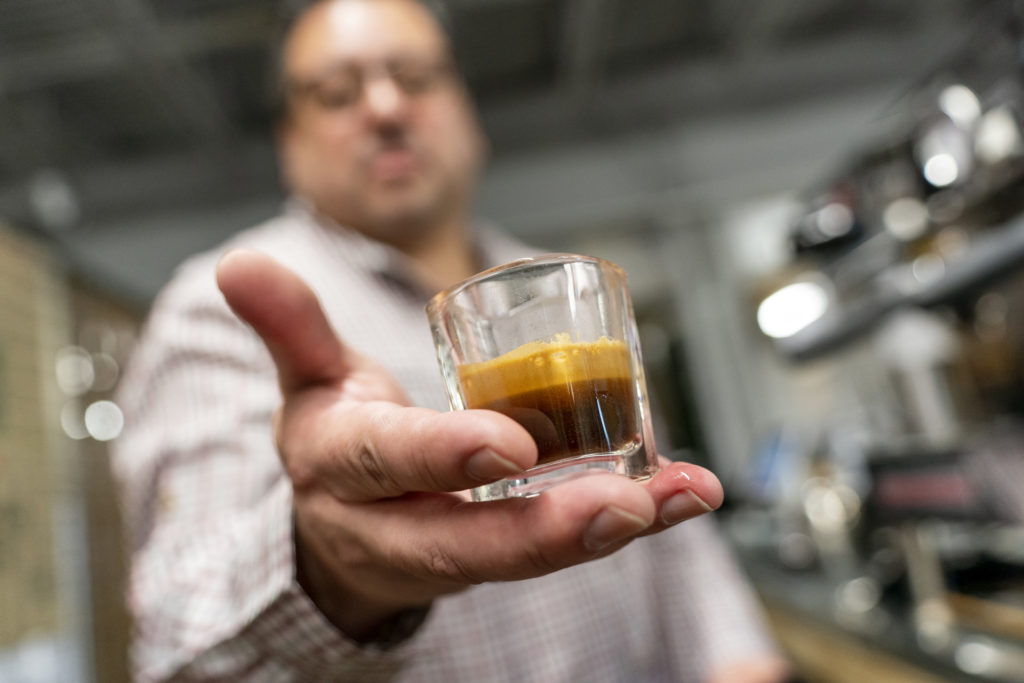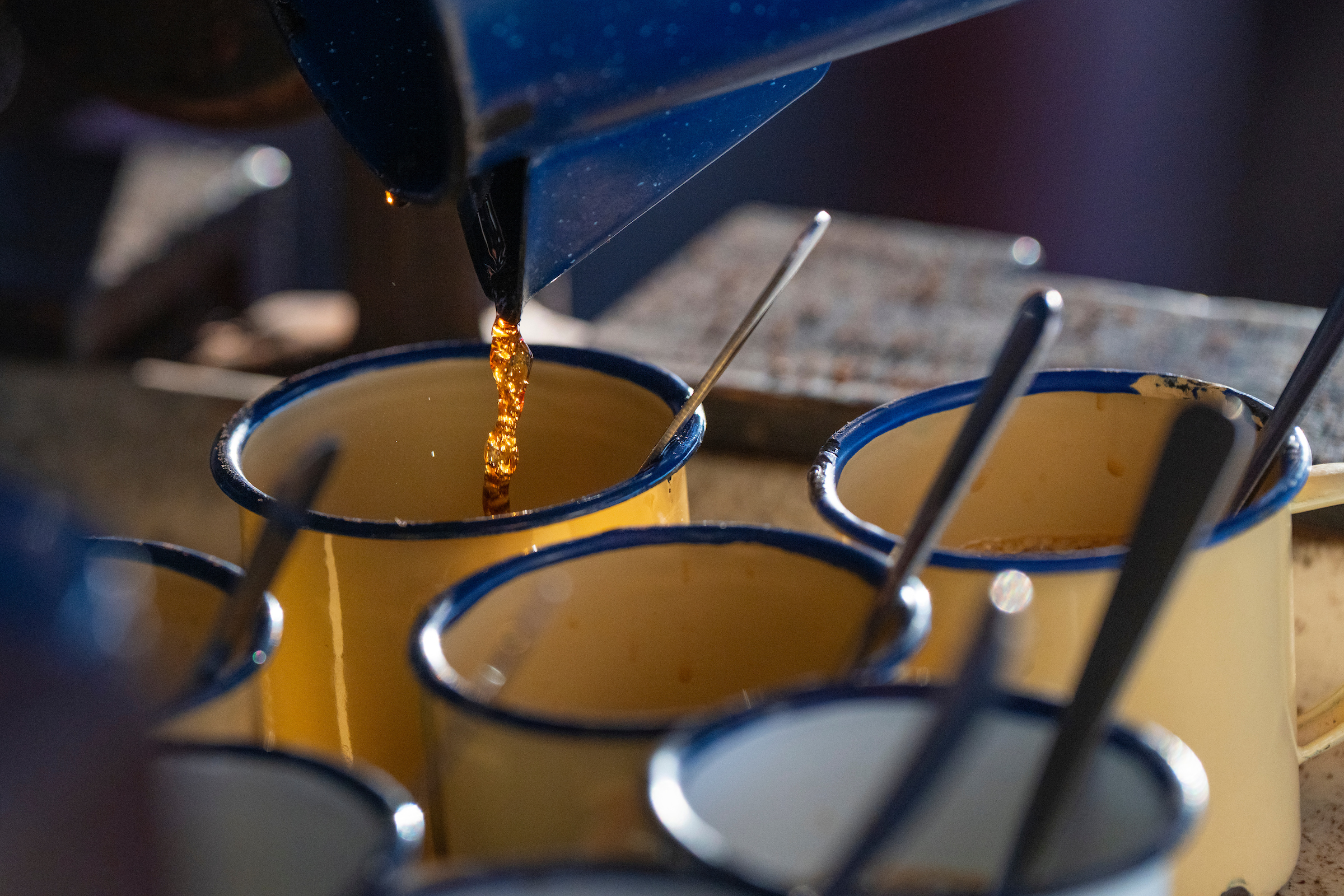A two-pronged approach to help small coffee farmers
Texas A&M's coffee center's Resilient Coffee, 12th Man Coffee projects help throughout the coffee value chain
The Center for Coffee Research and Education — a program of the Norman Borlaug Institute for International Agriculture, a unit of Texas A&M AgriLife — is trying to help small coffee farmers throughout the coffee value chain with a pair of projects.

The farm-to-table journey for a cup of coffee starts with the coffee plant. Supported by USAID [USAID closed] and implemented by Texas A&M AgriLife Research through the Borlaug Institute, the Resilient Coffee in Central America project helped bring hardier hybrids of coffee plants to Central American farmers. These specific hybrids help farmers produce larger, better-quality coffee crops earlier in the growing process.
The need to market coffee to consumers is on the other side of the farm-to-table journey. The 12th Man Coffee project helps small farmers do that by creating a direct market for their high-quality specialty coffee beans. Both projects involve farmer education and pursue the Borlaug Institute’s mission to help elevate smallholder farmers out of poverty.
“We implement projects all over the world to help small farmers,” said Eric Brenner, project coordinator for the coffee center. “Our work is an example of the work that Texas A&M University does all over the world, especially through the Borlaug Institute. This is a true reflection of the Aggie Spirit.”
Coffee crop and climate change basics
The morning cup of coffee drinkers love comes from the seed or “bean” of a coffee berry. Central American, Southeast Asian and equatorial African countries are the primary coffee growing areas.
The coffee American consumers drink comes from one of two different species of plants: Robusta and Arabica. Robusta is more disease resistant and grows at lower elevations in hotter temperatures. However, but it produces a more bitter cup of coffee. Arabica produces higher-quality beans for a smoother cup of coffee. It is also more sensitive to disease and must be grown at higher elevations.
Unfortunately, climate change is threatening those higher-quality Arabica coffee crops.
“Climate change has already driven Arabica coffees up about 100 meters (328 feet) up the slopes in Central America the last 10-15 years,” said Roger Norton, Ph.D., director of the coffee center. “They used to say Arabica coffee needs 900-1,000 meters (2,953-3,281 feet) of altitude. Now it is closer to 1,000-1,100 meters (3,281-3,609 feet).”
Coffee leaf rust is the primary economically relevant disease of coffee plants. The fungus easily spreads to and destroys the leaves of the plant and requires fungicides to control. A rust-infected plant does not produce coffee berries well, if at all, thereby reducing a producer’s income. The fungus can also kill the plant, which costs producers even more money.
The fungus thrives best in warmer, wetter environments. The increased temperatures of climate change have driven coffee leaf rust to ever-higher elevations. Arabica coffee is naturally less resistant to coffee rust, meaning it and its higher-quality product are at increased risk.
The state of the global coffee value chain
“Coffee is one of the major traded commodities in the world, second in value after petroleum,” Norton said. “However, coffee prices for the producer are low and that’s not going to change in the foreseeable future.”
Norton explained that prices are low both for supply and demand reasons. On the supply side, several countries, particularly Brazil and Vietnam, have entered the coffee market in recent years. These countries have begun producing a lot of Robusta coffee. This increased supply helps keep prices paid to farmers low.
On the demand side, commercial coffee buying infrastructure works to keep the prices paid to producers low too.
“There are basically four major multinationals in the food industry that are the main buyers of coffee in the world,” Norton said. “It’s what we call in economics an oligopoly. They control the market on the demand side. So, coffee prices are not going to come up for producers in the foreseeable future.”
About 80% of global coffee production comes from smallholder farmers, many of whom cannot support themselves on their coffee production alone. This is largely due to the economic impacts of climate change and coffee leaf rust, and the low prices paid for coffee.
“A lot of small farmers are in economic need,” said Rodrigo Chavez, former manager of the Borlaug Institute’s Resilient Coffee Project in Central America and owner/roaster of What’s the Buzz Coffee Co., the coffee center’s 12th Man Coffee project partner.
“The low prices are part of why we see a lot of migration from places like Guatemala. Farmers are leaving their coffee without being picked because the prices are so low,” Chavez said.
“What we need to do is emphasize quality, which gets them into a higher tier of prices,” Norton said.
This is where the coffee center’s two projects come in.
Helping with hybrids
The coffee center’s Resilient Coffee in Central America project was a three-year project that ran from 2018-2020 to help create a stronger coffee industry in El Salvador, Honduras and Guatemala. Through it, the coffee center helped disseminate two hybrid coffee varieties to small coffee farmers: Centroamericano and Milenio.
The hybrids are resistant to coffee leaf rust, meaning producers don’t have to spend as much money on fungicides. They also reach commercial productivity earlier and have a higher yield than traditional varieties, according to Norton.
“All those benefits help with the producers’ cash flow,” Norton said. “We’ve had 105 on-farm demonstration sites in Central America and producers are very enthusiastic. Producers have taken ownership of the varieties and they’re all quite excited about them.”
Norton explained that the project found smallholder coffee farmers in El Salvador, Honduras and Guatemala were barely surviving economically. Or so it seemed.
“Producers were not including the opportunity costs of the family labor and land that went into their coffee farms. Family could work in the small cities or on bigger farms, and their land could be used to grow fruit trees, both of which would be very profitable,” he said.
By not including the value of those resources in their calculations, most smallholder producers showed a slight net profit with traditional varieties. When those resources are included in the calculation, however, most producers were actually losing money.
“That’s why many of them are migrating,” Norton said. “But these hybrids have made a big difference. It can raise their incomes by 40-50% even when valuing land and family labor. Producers can make a real profit, especially with direct sales.”
Economic education and the resources to renovate
Both the Resilient Coffee in Central America and the 12th Man Coffee projects include education elements. They help small farmers produce more, better coffee through plantation renovation and to know the value of their coffee when they sell it.
Traditional Arabica coffee plants have a productive economic lifespan of about 15 to 20 years. After that age, the plants do not yield as much and are more susceptible to disease. This means they often cost more to maintain than they produce. However, many plants on Central American coffee plantations are much older, sometimes as old as 40-50 years. This is because renovating a coffee plantation takes money many producers don’t have, particularly with prices low.
“One of the ways that coffee farmers can make more money is through specialty coffee,” Brenner said. However, for producers to demand better prices for their coffee beans, they must first know the quality of their product.
“Many of the farmers had no idea about the quality of the coffee they were selling,” Brenner said. “Part of the work of the coffee center and its projects is to provide farmers with the knowledge they need when they deal with roasters or intermediaries.”
Norton explained that making them aware of the importance of bean quality — as well as on-farm management practices like drying and grading that help maintain and quantify quality — can make a huge difference in the prices they receive.
“Educating the farmers in that way is another contribution that we’re doing on quality and how to achieve it,” Norton said.
12th Man Coffee helping farmers and the coffee center
In addition to producer education, the 12th Man Coffee project aims to create a secure, direct market for producers of high-quality specialty coffee. Norton called this the “largest benefit of the 12th Man Coffee project.”
“That way producers don’t have to go scrambling around for a market and wind up selling their crop to whoever is willing to buy it at the moment at an unfair price,” Norton continued. “It helps introduce producers to high-quality roasters with good prices through direct sales.”
The 12th Man Coffee Project, in its partnership with What’s the Buzz Coffee Co., also helps the coffee center.
“The project does divert a small portion of its revenue to the coffee center, so it helps to continue our research and education efforts,” said Norton.
Despite the global economic importance of coffee, funding for coffee research is limited and competitive. This makes every potential source of funding important to the coffee center.
“The Resilient Coffee in Central America project focused on Central America, but there are so many other places that are in need,” Brenner said.
“There are countries in South America, Asia and Africa that need the sort of work we’ve done in Guatemala,” he continued. “We get emails from farmers from all over the world and our mission is to help farmers. But our ability to do that is definitely tied to the available funding.”
The 12th Man Coffee project is part of that picture.
“If we can have a sustainable base of funding, we can guarantee the continuity of our research and training work,” Norton said. “The 12th Man Coffee project is very helpful in helping us do that.”
To learn how to support the ongoing work at the Center for Coffee Research and Education at Norman Borlaug Institute for International Agriculture, contact Allyson Tjoelker ’02 at [email protected].





